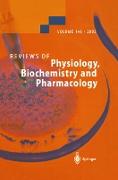- Start
- Reviews of Physiology, Biochemistry and Pharmacology
Reviews of Physiology, Biochemistry and Pharmacology
Angebote / Angebote:
Protein transport events occurring at the endoplasmic reticulum (ER) of eukaryotic cells and the cytoplasmic membrane of prokaryotic organisms share many similarities. Resident proteins of both membranes span the lipid bilayer once or several times by a-helical stretches and their integration is usually mediated by uncleaved signal-anchor sequences. Proteins that are translocated across either membrane, collectively also termed secretory proteins, harbour cleavable N-terminal signal sequences. Prokaryotic and eukaryotic signal sequences have the same modular structure and are functionally exchangeable. Integration of membrane proteins and translocation of secretory proteins basically occur at the same sites (pores) within each membrane. In both types of membranes, these pores are c- posed of homologous components forming the Sec translocons. Parts of the Sec trans- cons are found populated by ribosomes, the membrane-bound ribosomes. Bacterial m- brane and eukaryotic secretory proteins are targeted to the Sec translocons by the same molecular mechanism involving signal recognition particle (SRP) and its receptor (SRP - ceptor, SR). Structure and assembly of the SRP The functional core of SRP The functional core of this ribonucleoprotein complex consists of the signal sequence binding subunit (SRP54 in eukaryotes and Ffh in prokaryotes) and the SRP RNA molecule (see Fig. 1). This core is conserved in all organisms, with the intriguing exception of chloroplasts, where the SRP lacks the RNA subunit.
Folgt in ca. 5 Arbeitstagen

